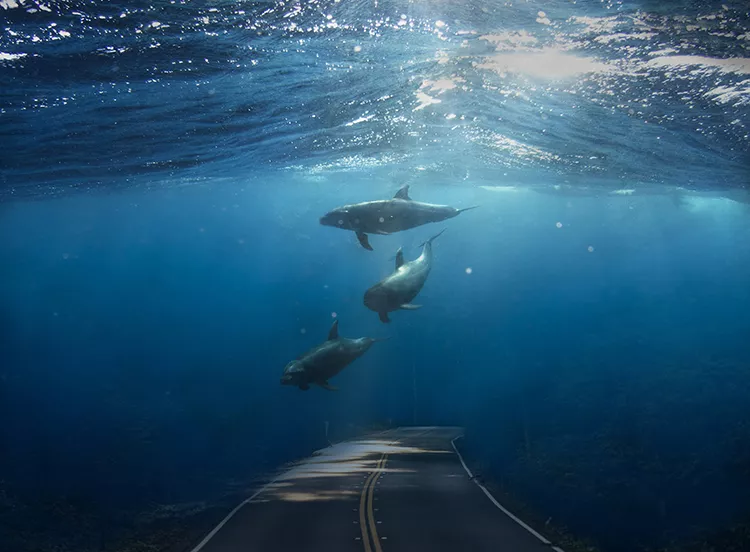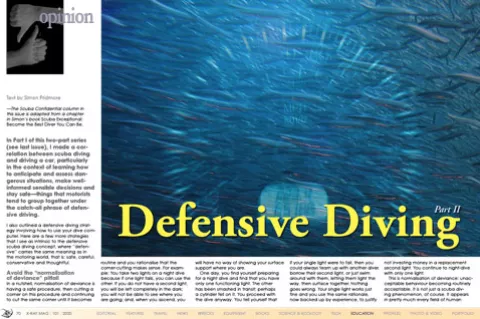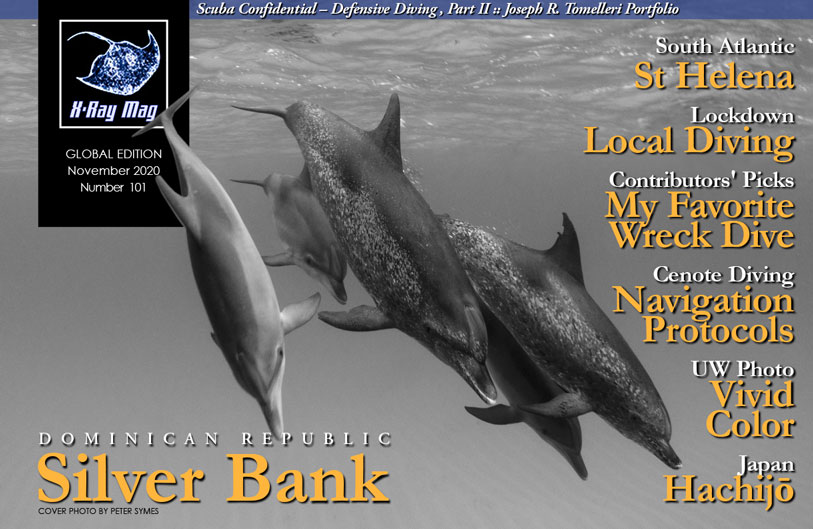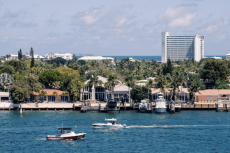In Part I of this two-part series (see issue 100), I made a correlation between scuba diving and driving a car, particularly in the context of learning how to anticipate and assess dangerous situations, make well-informed sensible decisions and stay safe—things that motorists tend to group together under the catch-all phrase of defensive driving.
Contributed by
Factfile
Simon Pridmore is the author of the international bestsellers Scuba Confidential: An Insider’s Guide to Becoming a Better Diver, Scuba Professional: Insights into Sport Diver Training & Operations and Scuba Fundamental: Start Diving the Right Way.
He is also the co-author of the Diving & Snorkeling Guide to Bali and the Diving & Snorkeling Guide to Raja Ampat & Northeast Indonesia.
His recently published books include The Diver Who Fell From The Sky, Dive into Taiwan, Scuba Exceptional: Become the Best Diver You Can Be, Scuba Physiological: Think You Know All About Scuba Medicine? Think Again! and the Dining with Divers series of cookbooks.
For more information, see his website at: SimonPridmore.com.
I also outlined a defensive diving strategy involving how to use your dive computer. Here are a few more strategies that I see as intrinsic to the defensive scuba diving concept, where “defensive” carries the same meaning as in the motoring world, that is: safe, careful, conservative and thoughtful.
Avoid the “normalisation of deviance” pitfall
In a nutshell, normalisation of deviance is having a safe procedure, then cutting a corner on this procedure and continuing to cut the same corner until it becomes routine and you rationalise that the corner-cutting makes sense.
For example: You take two lights on a night dive because if one light fails, you can use the other. If you do not have a second light, you will be left completely in the dark; you will not be able to see where you are going; and, when you ascend, you will have no way of showing your surface support where you are.
One day, you find yourself preparing for a night dive and find that you have only one functioning light. The other has been smashed in transit; perhaps a cylinder fell on it. You proceed with the dive anyway.
You tell yourself that if your single light were to fail, then you could always team up with another diver, borrow their second light, or just swim around with them, letting them light the way, then surface together.
Nothing goes wrong. Your single light works just fine and you use the same rationale, now backed up by experience, to justify not investing money in a replacement second light. You continue to night-dive with only one light.
This is normalisation of deviance: unacceptable behaviour becoming routinely acceptable. It is not just a scuba diving phenomenon, of course. It appears in pretty much every field of human activity. Nor is it merely an individual phenomenon; it can affect or infect an entire community. And it does seem to be something that we scuba divers excel at.
Think about some of the things that scuba divers do all the time. For instance, recreational divers continue to dive when they are very low on air and regularly go into deco on a single cylinder.
Meanwhile, technical divers often dive in overhead environments without a back-up buoyancy device, carry insufficient open-circuit bailout when using a CCR, or extend the life of CO2 absorbent beyond manufacturer and industry recommended limits.
It is a matter of mindset. Having bypassed an established procedure and got away with it, some divers may argue, “I didn’t come to harm nor did I find myself in danger, therefore the procedure must be unnecessary or exaggerated,” or else, “I didn’t come to harm nor did I find myself in danger, therefore I must be special in some way—some kind of diving superhero.”
A defensive diver will take the opposite view and say, “I made a mistake and I got away with it. That will never happen again. In fact, what can I do to make sure I never make that mistake again?”
Do not abandon responsibility for your dive
Never follow a divemaster or dive guide blindly and without question. Never give anyone complete authority over your dive. Scuba diving professionals are just people. People get things wrong, people overestimate their abilities, people get distracted, people get tired.
Make sure that you are actively involved in all decisions concerning the dive, that you know the dive plan, understand your role in the team and have an idea of who your fellow divers are and how experienced they are.
Be prepared to take full responsibility for yourself during the dive and also be prepared to assist one of your teammates or even your divemaster or guide if they get into difficulty. It happens.
Assume the worst
This strategy is similar to the “what-if” concept but, whereas “what if” refers primarily to an approach to choosing and configuring equipment, “assume the worst” is more a question of attitude. There is a parallel here with the advice commonly given to inexperienced drivers: Always to assume that every other driver on the road is an idiot and prepare to act accordingly.
From a scuba diving point of view, this equates, among other things, to the following:
a) Assume that the person you are diving with is going to get into trouble and is going to need your help.
b) At the same time, assume that you will have a problem during the dive and will have to deal with it on your own.
c) Assume that diving conditions will deteriorate during the dive and that you may have to abort.
d) Assume that the boat will not be there when you ascend and that you will have to help the crew find you.
e) Assume that the boat will not turn up and that you will need a plan B; for example, swim to shore or prepare to be floating for a long time until searchers or fortuitous fishermen come by.
f) Make sure each piece of your equipment is functioning properly before every dive, but still assume that it is going to fail, just when you need it the most.
Be constantly attentive
There are four main aspects to this:
1. Replace or repair anything that malfunctions during a dive before the next dive; this includes leaky O-rings and hoses.
2. Look ahead and think ahead. Early recognition of potential problems gives you more time to react. Do not forget to look behind you too, especially if you are in a shipwreck or cavern. You will probably need to pass this way again on exit. Be alert for signs of changing water conditions. Look up to the surface from time to time to see what is happening there.
3. Always be aware of how you are diving and how you look in the water. Think about your trim, how you are streamlined, what your fins are doing and what your arms are doing.
4. Dive the same way as you drive. Watch the ocean as you watch the road. Keep your eye on other divers in the water, like you do other drivers. Anticipate what they may do and be prepared. A diver with poor fin control in a confined space can quickly reduce the visibility in that space.
A heavy breather may run out of air quickly. Someone else’s problem can always become your problem too. In my career, two out-of-air divers have torn the regulator out of my mouth (and ripped my mask off in the process) in their desperation to find a source of air to breathe. Neither was part of my group.
Build in buffers
Buffers or safety margins are small protective mechanisms that you can include in your dive plan to make a dive safer. Not going deeper than you need to be is a buffer. Making a longer safety stop at 3m to 6m is a buffer, as is ascending more slowly than the maximum recommended rate of 9m per minute.
Diving on nitrox with your dive computer set to air is also a buffer. As long as you do not descend deeper than the maximum operating depth of the nitrox mix, there is absolutely no reason why this is not completely safe. It is an excellent way to reduce the risk of decompression sickness, particularly if you are on a multiday dive trip with several dives a day.
Make it a habit to do longer surface intervals between dives rather than calculating minimum surface intervals to cram as much diving time into a diving day. If you want to spend more time in the water, a much better way of doing this is to spend an extended period shallower than 9m at the end of each dive. During this time, your body will be releasing inert gas accumulated during the deeper part of your dive. Experiments that monitor the presence of tiny bubbles in divers after diving have shown that this practice reduces a diver’s post-dive bubble count considerably.
Build buffers into all aspects of your dive planning and execution. Be thoughtful and develop a defensive mindset along the lines set out here. You will find that focussing on safety as your priority carries no downside in terms of the quality of your diving. ■
The Scuba Confidential column in issue #102 is adapted from a chapter in Simon’s book Scuba Exceptional: Become the Best Diver You Can Be.



























